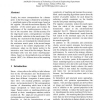Free Online Productivity Tools
i2Speak
i2Symbol
i2OCR
iTex2Img
iWeb2Print
iWeb2Shot
i2Type
iPdf2Split
iPdf2Merge
i2Bopomofo
i2Arabic
i2Style
i2Image
i2PDF
iLatex2Rtf
Sci2ools
VMV
2001
2001
Search Space Reduction in the Edge Based Stereo Correspondence
Usually, the stereo correspondence for a feature point in the first image is obtained by searching in a predefined region of the second image, based on the epipolar line and the maximum disparity. The reduction of the search space can increase the performance of the matching process, in the co text of the execution time and the accuracy. For the edge-based stereo correspondence, we obtain the noticeable reduction in the search space. Considering the maximum of the disparity gradient in the real scene, we formulated the relation between the maximum search space in the second images with respect to the relative displacement of the continuous edges (as the feature points) in the successive scan lines of the first images. Then we developed some very fast stereo matching algorithms, based on the normalized cross correlation criteria (NCC) for different sizes of the matching block.
| Added | 31 Oct 2010 |
| Updated | 31 Oct 2010 |
| Type | Conference |
| Year | 2001 |
| Where | VMV |
| Authors | Payman Moallem, Karim Faez |
Comments (0)

